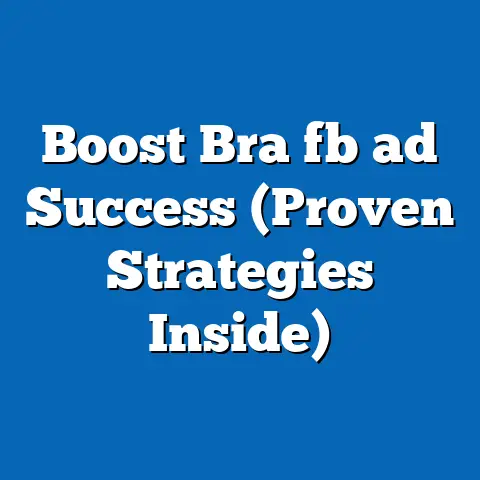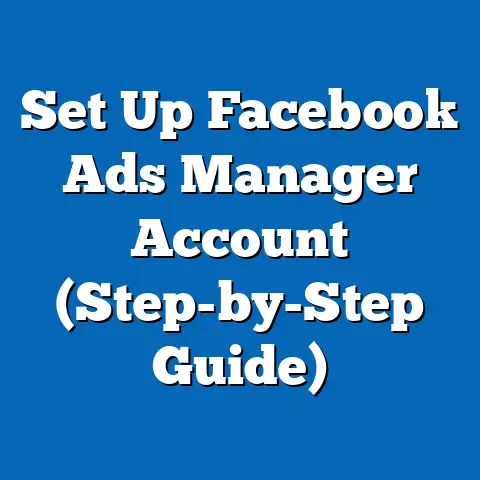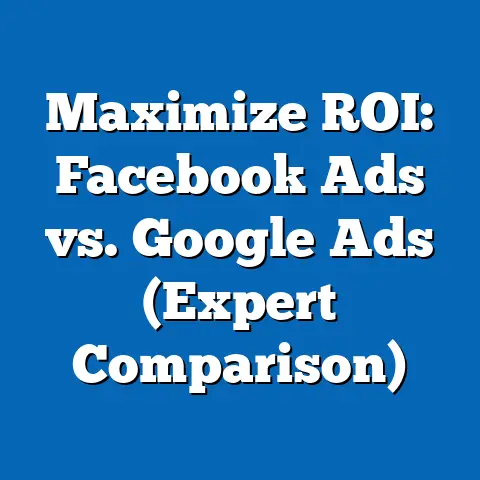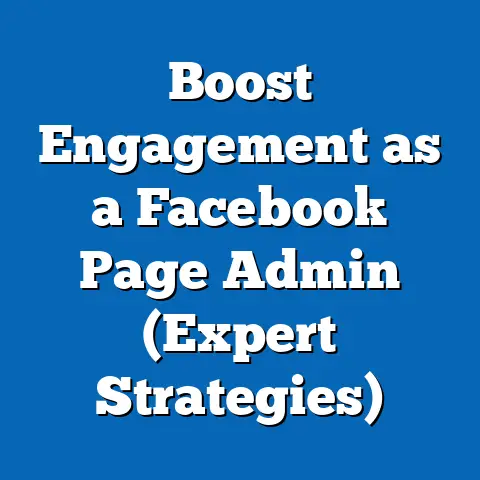Master Funnel Facebook Ads (Proven Strategies for Success)
I’ve always been fascinated by the concept of “smart living.” It’s not just about having the latest gadgets or living in a high-tech home. For me, smart living embodies efficiency, innovation, and effectiveness in everyday choices and decisions. It’s about making the most of your resources and time to achieve your goals with minimal waste. And in today’s fast-paced business world, this philosophy is more relevant than ever.
Businesses today must adopt smart strategies in digital marketing to thrive, especially in the realm of Facebook advertising. The digital landscape is constantly evolving, and simply throwing money at ads without a clear strategy is a recipe for disaster. It’s like trying to fill a leaky bucket – you’ll just end up wasting your resources and getting nowhere. That’s why I’m a firm believer in the power of a well-defined sales funnel to guide your Facebook Ad campaigns.
Think of a sales funnel as a roadmap for your potential customers. It outlines the steps they take from initially becoming aware of your brand to eventually making a purchase. And by aligning your Facebook Ads with each stage of this journey, you can significantly increase your chances of success.
In this article, I’m going to walk you through the proven strategies I’ve used to master Facebook Ads using a funnel approach. I’ll share my personal experiences, insights, and practical tips that you can implement immediately to enhance your campaigns. Whether you’re a seasoned marketer or just starting out, this guide will provide you with the knowledge and tools you need to create effective Facebook Ads that drive results. Let’s dive in!
Section 1: Understanding the Sales Funnel
The sales funnel, at its core, is a visual representation of the customer journey. It illustrates the stages a potential customer goes through, from initial awareness to becoming a loyal buyer. Understanding this funnel is crucial because it allows you to tailor your marketing efforts to meet the specific needs and interests of customers at each stage.
Think of it like this: you wouldn’t propose marriage on a first date, right? Similarly, you wouldn’t bombard someone who’s just learned about your brand with a hard-sell ad. You need to nurture the relationship and guide them along the path to conversion.
Here’s a breakdown of the typical stages of a sales funnel:
- Awareness: This is the top of the funnel, where potential customers first become aware of your brand or product. They might see your ad, read a blog post, or hear about you from a friend.
- Interest: In this stage, prospects are actively researching and learning more about your offerings. They’re comparing you to competitors and trying to determine if you can solve their problem.
- Decision: Here, prospects are seriously considering making a purchase. They might read reviews, ask for recommendations, or compare pricing.
- Action: This is the bottom of the funnel, where prospects finally take the plunge and become customers. They make a purchase, sign up for a service, or take whatever action you’re hoping for.
Aligning Facebook Ads with the Customer Journey
The real magic happens when you align your Facebook Ads with the specific stage of the customer journey. This means creating different types of ads and using different targeting strategies for each stage of the funnel.
For example, at the Awareness stage, your goal is simply to get your brand in front of as many relevant people as possible. You might use broad targeting and create ads that are visually appealing and informative, focusing on brand awareness and generating interest. Think videos, eye-catching images, and engaging stories.
In the Interest stage, you want to provide more detailed information about your products or services. You can use ads that highlight the benefits of your offerings and address common pain points. This is a good time to use carousel ads to showcase multiple products or features.
During the Decision stage, you need to build trust and credibility. This is where you can use ads that feature customer testimonials, case studies, or special offers. Retargeting ads that remind prospects of your product and offer a discount can be very effective at this stage.
Finally, in the Action stage, you want to make it as easy as possible for prospects to convert. Use ads that include a clear call-to-action and direct them to your website or landing page. Consider using Facebook Lead Ads to capture contact information directly from the platform.
Real-World Examples of Funnel Success
I’ve seen firsthand how powerful a well-executed funnel strategy can be. One of my clients, a local bakery, was struggling to attract new customers. They were running generic Facebook Ads that weren’t resonating with their target audience.
We decided to implement a funnel strategy. At the Awareness stage, we ran ads featuring mouthwatering photos of their pastries, targeting people interested in baking and local food. In the Interest stage, we ran ads showcasing their custom cake designs and highlighting their catering services. For the Decision stage, we retargeted website visitors with ads offering a free cupcake with their next order.
The results were astounding. Their website traffic increased by 30%, and their sales soared by 20%. By aligning their Facebook Ads with the customer journey, they were able to attract, engage, and convert more customers than ever before.
Key Takeaway: Understanding the sales funnel and aligning your Facebook Ads with each stage is crucial for maximizing your advertising effectiveness. Tailor your ads and targeting strategies to meet the specific needs and interests of customers at each stage of the journey.
Section 2: Crafting Compelling Facebook Ads
Creating compelling Facebook Ads is an art and a science. It requires a deep understanding of your target audience, a knack for crafting persuasive copy, and an eye for visually appealing design. But don’t worry, it’s a skill you can develop with practice and by following some key principles.
In my experience, the most successful Facebook Ads have four key elements in common:
- Visuals: A captivating image or video that grabs attention and conveys your message.
- Copy: Compelling and concise text that highlights the benefits of your product or service.
- Call-to-Action (CTA): A clear and persuasive prompt that tells the user what you want them to do.
- Audience Targeting: Reaching the right people with the right message at the right time.
Attention-Grabbing Visuals
In a world of endless scrolling, your ad’s visual is your first and often only chance to make an impression. Choose images or videos that are high-quality, relevant to your target audience, and visually appealing.
Here are a few tips for creating attention-grabbing visuals:
- Use bright colors and bold designs.
- Showcase your product in action.
- Use human faces to create an emotional connection.
- Keep videos short and engaging.
- Test different visuals to see what resonates best with your audience.
I remember working with a fitness studio that was struggling to attract new members. Their initial Facebook Ads featured generic stock photos of people working out. We decided to experiment with user-generated content, asking their existing members to share photos and videos of themselves at the studio.
The results were incredible. The user-generated content felt more authentic and relatable, and the ads generated significantly more engagement and leads. It just goes to show that sometimes the best visuals are the ones you don’t create yourself.
Compelling Ad Copy
Your ad copy should be clear, concise, and persuasive. Highlight the benefits of your product or service and address the pain points of your target audience. Use strong verbs and active language to create a sense of urgency.
Here are a few tips for writing compelling ad copy:
- Know your audience and speak their language.
- Focus on the benefits, not just the features.
- Use strong verbs and active language.
- Keep it short and sweet.
- Test different headlines and body copy to see what performs best.
I’ve found that using storytelling in your ad copy can be incredibly effective. People love stories, and they’re more likely to remember your message if it’s presented in a narrative format.
For example, instead of simply saying “Our product will save you time,” you could say “Imagine having an extra hour in your day. Our product can help you reclaim your time and focus on what matters most.”
Effective CTAs
Your call-to-action is the final piece of the puzzle. It tells the user what you want them to do next. Use clear and concise language and make sure your CTA is visually prominent.
Here are a few examples of effective CTAs:
- Shop Now
- Learn More
- Sign Up
- Get Started
- Download Now
The key is to choose a CTA that aligns with the stage of the funnel and the overall goal of your ad. If you’re running an awareness campaign, a “Learn More” CTA might be more appropriate than a “Shop Now” CTA.
Key Takeaway: Crafting compelling Facebook Ads requires a combination of visually appealing design, persuasive copy, and a clear call-to-action. Tailor your ads to the specific stage of the funnel and always be testing to see what resonates best with your audience.
Section 3: Targeting Your Audience Effectively
Targeting is arguably the most important aspect of Facebook advertising. You can have the most beautiful ad in the world, but if you’re showing it to the wrong people, it’s not going to generate any results.
Facebook offers a wide range of targeting options, allowing you to reach specific demographics, interests, behaviors, and even custom audiences. Let’s explore some of the most effective targeting options:
Demographics
Demographic targeting allows you to reach people based on their age, gender, location, education, and other demographic characteristics. This is a good starting point for most campaigns, but it’s important to refine your targeting further to reach the most relevant audience.
For example, if you’re selling baby products, you might target parents aged 25-45 who live in your local area.
Interests
Interest-based targeting allows you to reach people based on their interests, hobbies, and activities. This is a powerful way to reach people who are passionate about a particular topic or industry.
For example, if you’re selling fitness equipment, you might target people interested in weightlifting, yoga, or running.
Behaviors
Behavior-based targeting allows you to reach people based on their online and offline behaviors, such as their purchase history, travel habits, and device usage. This is a highly targeted option that can be very effective for reaching specific segments of your audience.
For example, if you’re selling luxury travel packages, you might target people who have recently booked international flights or stayed at high-end hotels.
Custom Audiences
Custom audiences allow you to upload your own customer data, such as email addresses or phone numbers, and target those people directly on Facebook. This is a great way to reach your existing customers or prospects with targeted ads.
You can also create custom audiences based on website traffic, app activity, or engagement with your Facebook page. This allows you to retarget people who have already interacted with your brand.
Lookalike Audiences
Lookalike audiences allow you to create new audiences that are similar to your existing customers or website visitors. Facebook uses its sophisticated algorithms to identify people who share similar characteristics and behaviors with your source audience.
This is a powerful way to expand your reach and find new customers who are likely to be interested in your products or services.
A/B Testing Audience Segments
The key to successful targeting is to constantly test different audience segments to see what performs best. A/B testing allows you to compare the performance of two different audience segments and determine which one is more responsive to your ads.
For example, you might test targeting people interested in “yoga” versus people interested in “Pilates” to see which audience generates more leads for your fitness studio.
Key Takeaway: Effective targeting is crucial for the success of your Facebook Ad campaigns. Explore the various targeting options available and constantly test different audience segments to see what resonates best with your target audience.
Section 4: Utilizing Retargeting Strategies
Retargeting is one of the most powerful tools in the Facebook advertising arsenal. It allows you to show ads to people who have already interacted with your brand, such as website visitors, app users, or Facebook page engagers.
Think of it like this: someone visits your website, browses a few products, but doesn’t make a purchase. They leave your site and go about their day. Without retargeting, that potential customer is lost forever. But with retargeting, you can show them ads that remind them of your products and encourage them to come back and complete their purchase.
Setting Up Retargeting Campaigns
Setting up retargeting campaigns on Facebook is relatively straightforward. You’ll need to install the Facebook Pixel on your website, which is a small piece of code that tracks user behavior.
Once the pixel is installed, you can create custom audiences based on website traffic, app activity, or engagement with your Facebook page. You can then target these audiences with specific ads that are tailored to their previous interactions with your brand.
Creating Retargeting Ads That Convert
Retargeting ads should be different from your initial awareness ads. They should be more focused on driving conversions and encouraging people to take action.
Here are a few strategies for creating retargeting ads that convert:
- Offer a special promotion or discount. This is a great way to incentivize people to come back and make a purchase.
- Showcase customer testimonials or reviews. Building trust and credibility is crucial for converting hesitant prospects.
- Highlight the benefits of your product or service. Remind people why they were interested in your offerings in the first place.
- Use dynamic product ads. These ads automatically show the products that people have previously viewed on your website.
I remember working with an e-commerce client who was struggling with a high cart abandonment rate. We implemented a retargeting campaign that showed ads featuring the exact products that people had left in their carts. We also offered a 10% discount to encourage them to complete their purchase.
The results were remarkable. Their cart abandonment rate decreased by 20%, and their sales increased significantly. Retargeting proved to be a highly effective strategy for recovering lost sales.
Metrics to Monitor Retargeting Success
It’s important to monitor the performance of your retargeting campaigns to ensure they’re generating a positive return on investment. Here are a few key metrics to track:
- Conversion Rate: The percentage of people who see your ad and then take the desired action (e.g., make a purchase, sign up for a service).
- Cost Per Conversion: The amount of money you spend to generate one conversion.
- Return on Ad Spend (ROAS): The amount of revenue you generate for every dollar you spend on advertising.
By monitoring these metrics, you can identify areas for improvement and optimize your retargeting campaigns for maximum effectiveness.
Key Takeaway: Retargeting is a powerful tool for driving conversions and recovering lost sales. Set up retargeting campaigns on Facebook and create ads that are tailored to the specific interactions people have had with your brand. Monitor your metrics and optimize your campaigns for maximum effectiveness.
Section 5: Analyzing and Optimizing Facebook Ads
Data analysis is the backbone of any successful Facebook Ad campaign. Without data, you’re just guessing. By tracking key performance indicators (KPIs) and analyzing your results, you can identify what’s working and what’s not, and make informed decisions to optimize your campaigns for maximum effectiveness.
Key Performance Indicators (KPIs)
Here are some of the most important KPIs that marketers should track:
- Click-Through Rate (CTR): The percentage of people who see your ad and click on it. A high CTR indicates that your ad is relevant and engaging to your target audience.
- Conversion Rate: The percentage of people who click on your ad and then take the desired action (e.g., make a purchase, sign up for a service). A high conversion rate indicates that your landing page is effective and your offer is compelling.
- Cost Per Click (CPC): The amount of money you spend for each click on your ad. A low CPC indicates that your ad is efficient and you’re not overpaying for traffic.
- Cost Per Conversion: The amount of money you spend to generate one conversion. A low cost per conversion indicates that your campaign is efficient and you’re generating a positive return on investment.
- Return on Ad Spend (ROAS): The amount of revenue you generate for every dollar you spend on advertising. A high ROAS indicates that your campaign is highly profitable.
Tools and Resources for Analyzing Performance
Facebook Ads Manager is the primary tool for analyzing your ad performance. It provides a wealth of data and insights that can help you optimize your campaigns.
Here are a few of the key features of Facebook Ads Manager:
- Real-time reporting: Track your key metrics in real-time and see how your ads are performing.
- Customizable dashboards: Create custom dashboards that display the metrics that are most important to you.
- A/B testing: Run A/B tests to compare the performance of different ads, targeting options, and bidding strategies.
- Attribution modeling: Understand how different touchpoints contribute to your conversions.
In addition to Facebook Ads Manager, there are also a number of third-party analytic tools that can provide additional insights and features. Some popular options include:
- Google Analytics: Track website traffic and conversions.
- Kissmetrics: Analyze user behavior and identify drop-off points in your funnel.
- Mixpanel: Track user engagement and identify opportunities for improvement.
Actionable Steps for Optimizing Ad Performance
Based on your data analysis, you can take a number of actionable steps to optimize your ad performance:
- Refine your targeting. If your CTR is low, try refining your targeting to reach a more relevant audience.
- Improve your ad copy and visuals. If your CTR is low, try improving your ad copy and visuals to make them more engaging and persuasive.
- Optimize your landing page. If your conversion rate is low, try optimizing your landing page to make it more user-friendly and compelling.
- Adjust your bidding strategy. If your CPC is high, try adjusting your bidding strategy to lower your costs.
- Refresh your ads. Over time, your audience will become fatigued with your ads. Refresh your ads regularly to keep them fresh and engaging.
- Adjust your budget. If your campaign is performing well, consider increasing your budget to reach more people. If your campaign is underperforming, consider decreasing your budget or pausing it altogether.
Key Takeaway: Data analysis is essential for optimizing your Facebook Ad campaigns. Track your key metrics, analyze your results, and take actionable steps to improve your performance.
Conclusion
In this article, I’ve shared the proven strategies I’ve used to master Facebook Ads using a funnel approach. We’ve covered everything from understanding the sales funnel and crafting compelling ads to targeting your audience effectively and analyzing your performance.
I hope you’ve found this guide to be informative and actionable. But remember, success in Facebook Ads requires continuous learning and adaptation. The platform is constantly evolving, and what works today might not work tomorrow.
That’s why it’s so important to stay up-to-date with the latest trends and best practices. Read industry blogs, attend webinars, and experiment with new features and strategies.
Mastering Facebook Ads through a well-structured funnel can significantly contribute to smart living for businesses, leading to increased efficiency, better customer engagement, and ultimately, business growth. By implementing these strategies, you can unlock the full potential of Facebook advertising and achieve your business goals.
So, go out there, create some amazing ads, and start driving results! I’m confident that with a little bit of effort and dedication, you can master Facebook Ads and achieve your business goals. Good luck!






